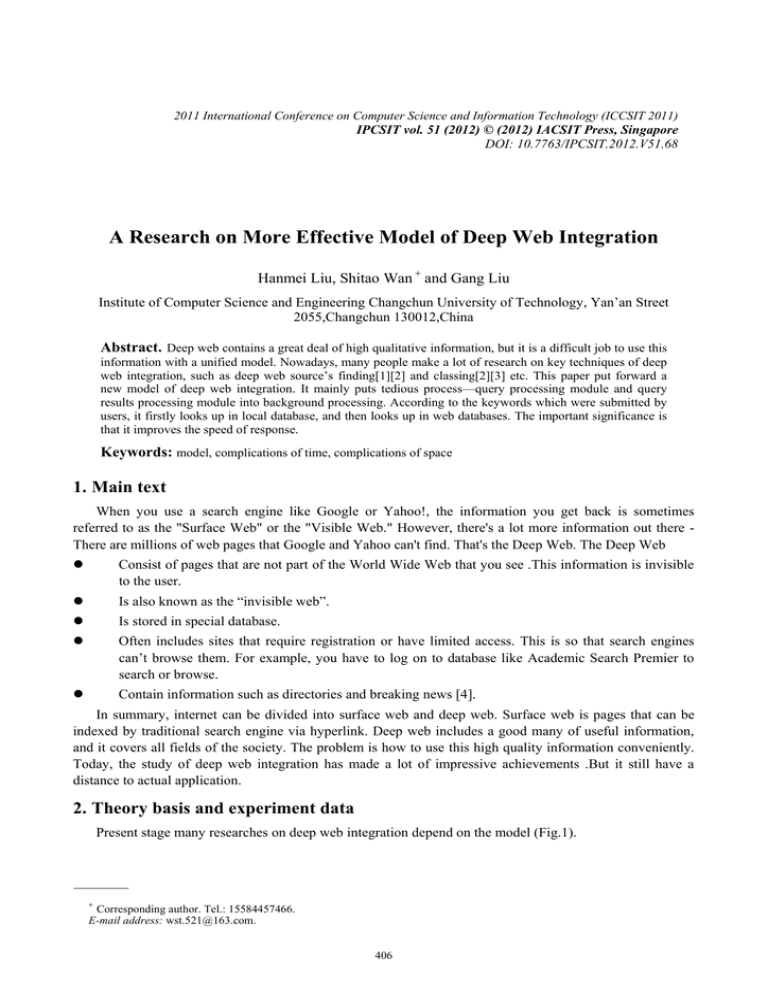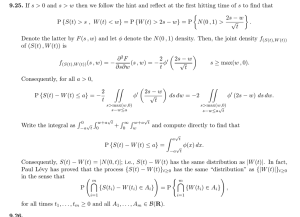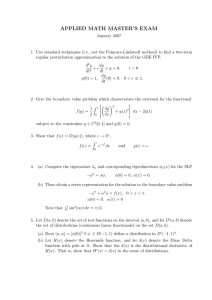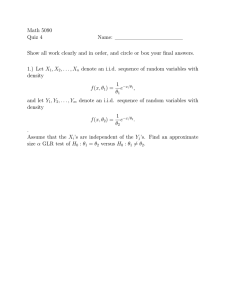Document 13135957
advertisement

2011 International Conference on Computer Science and Information Technology (ICCSIT 2011)
IPCSIT vol. 51 (2012) © (2012) IACSIT Press, Singapore
DOI: 10.7763/IPCSIT.2012.V51.68
A Research on More Effective Model of Deep Web Integration
Hanmei Liu, Shitao Wan and Gang Liu
Institute of Computer Science and Engineering Changchun University of Technology, Yan’an Street
2055,Changchun 130012,China
Abstract. Deep web contains a great deal of high qualitative information, but it is a difficult job to use this
information with a unified model. Nowadays, many people make a lot of research on key techniques of deep
web integration, such as deep web source’s finding[1][2] and classing[2][3] etc. This paper put forward a
new model of deep web integration. It mainly puts tedious process—query processing module and query
results processing module into background processing. According to the keywords which were submitted by
users, it firstly looks up in local database, and then looks up in web databases. The important significance is
that it improves the speed of response.
Keywords: model, complications of time, complications of space
1. Main text
When you use a search engine like Google or Yahoo!, the information you get back is sometimes
referred to as the "Surface Web" or the "Visible Web." However, there's a lot more information out there There are millions of web pages that Google and Yahoo can't find. That's the Deep Web. The Deep Web
Consist of pages that are not part of the World Wide Web that you see .This information is invisible
to the user.
Is also known as the “invisible web”.
Is stored in special database.
Often includes sites that require registration or have limited access. This is so that search engines
can’t browse them. For example, you have to log on to database like Academic Search Premier to
search or browse.
Contain information such as directories and breaking news [4].
In summary, internet can be divided into surface web and deep web. Surface web is pages that can be
indexed by traditional search engine via hyperlink. Deep web includes a good many of useful information,
and it covers all fields of the society. The problem is how to use this high quality information conveniently.
Today, the study of deep web integration has made a lot of impressive achievements .But it still have a
distance to actual application.
2. Theory basis and experiment data
Present stage many researches on deep web integration depend on the model (Fig.1).
Corresponding author. Tel.: 15584457466.
E-mail address: wst.521@163.com.
406
Fig.1: Frame of deep web integration.
This model consists of three modules: integrating query interfaces module, query processing module and
query results processing module. The process—searching content user wanted and merging results that
returned by each on-line database is considered the most time consuming part. It has a lot of reasons: the
effect of network condition, the different design model among these on-line databases and the speed of
response of each on-line database. Besides, the part of merging returned results should consider how to take
on theses web pages. Finally, system should delete repeat content, range content and generate web pages
which user would see. We assume that this system composed by N web databases, and suppose one user, one
submission. Then system would create N threads and they carry out query. Assuming that each on-line
database’s access time are T i (i=1,2,……), obviously, using linear dispatch, even it don’t consider time of
N
T
i
semantic label, synthesizing web pages and removing repeats, the total time is i 1 .We are easy to see that
its efficiency is too low. Naturally intercurrent dispatch would be adopted. But, when M users access the
system at the same time, dispatch algorithm would be more complicated. And system would take (M+1)*N
thread’s dispatch into account. Meantime, it needs to consider restriction in different mode of each web
database [3].
2.1. Analysis for complication of time and space of Fig.1
Hypothesis: T 1 denote integrating query interfaces module; T 2 denote query processing module;
T 3 denote query results processing module ; T 0 denote the part of searching in web database. The time of
each submodule: T 00 denote a access to one web database, suppose it contains H web database, then the total
time is H* T 00 ; T 11 denote web database’s discover; T 12 denote extract of query interface schema; T 13
denote classing web databases; T 14 denote integrating query interfaces; T 21 denote selecting web databases;
T 22 denote conversion of query; T 23 denote submitting query; T 31 denote extract of query results; T 32 denote
results’ note; T 33 denote merging results.
In user’s opinion, T 1 is done in prophase. Time is spend on T 0 , T 2 , and T 3 .Then user submit one query
and see results would spend total time T= T 0 + T 2 + T 3 .And, T 0 = H* T 00 , T 2 = T 21 + T 22 + T 23 ,T 3 = T 31 +
T 32 + T 33 .So, T= H* T 00 + T 21 + T 22 + T 23 + T 31 + T 32 + T 33 .This model’s complication of space is low,
because it doesn’t impropriate much more storage. It wills impropriate much more CPU.
2.2. Experiment data and its analysis
Many researches express that the most satisfied time of open web page is lower than 2s. And the time
which users can stand is 8s.That is to say, 8s is a critical value. If a website be opened more than 8s, it is very
possible for users to leave this website [6]. So it is a question that must be solved.
Before this, I do a survey .For some field; several databases can cover most content of this field. For
example, it is obvious at railroad information service. It is provided by government or related authority, such
as
the
railroad
customer
service
center
of
China
(http://dynamic.12306.cn/TrainQuery/trainPassStationByTrainCode.jsp), India railroad service net
407
(http://www.indianrail.gov.in/), British railroad information net (http://www.trainenquiry.com/indexNS.aspx)
and European railway network (http://www.raileurope.cn/).So it is adequate to update data with several web
databases. Besides, we observe some e-commerce website. We input “C++” in query interface of Dangdang
web and Amazon web, and it return 1590 records, 992 records. These records cover both domestic and
overseas relevant books. They cover from introduction to proficiency of C++ and its application in every
field. But in fact user needn’t to look over 2582 records. Perhaps user wants only one book. When the
system is integrating records, what need may be the adoption of top N records. We once did a meticulous
survey about each shopping website, and mainly look the access quantity of IP and PV (page view).
Meantime, we range these websites. Results are follows (March.31th.2011) [7]:
Table 1. Shopping website taxis
Website name
Website address
mean of one day’s IP access
quantity[one week]
mean of one day’s PV
access quantity[one week]
Taobaowang
www.taobao.com
23,340,000
490,140,000
eBay
www.ebay.com
16,134,000
307,191,360
jindongshangcheng
www.360buy.com
3,282,000
35,511,240
fankechengpin
www.vancl.com
1,650,000
14,355,000
paipaiwang
www.paipai.com
2,004,000
12,945,840
dangdangwang
www.dangdang.com
1,302,000
12,759,600
amazon
www.amazon.com
1,920,000
12,230,400
walmart
www.walmart.com
2,112,000
12,080,640
bestbuy
www.bestbuy.com
1,632,000
10,559,040
target
www.target.com
1,710,000
8,652,600
360huicongwang
www.hc360.com
1,332,000
7,738,920
lashouwang
www.lashou.com
1,794,000
5,884,320
meituanwang
www.meituan.com
1,185,000
4,261,440
nuomiwang
www.nuomi.com
570,000
1,710,000
24tuan
www.24tuan.com
414,000
1,204,740
Ftuan
www.ftuan.com
294,000
1,146,600
maigouwang
www.maigoo.com
90,600
190,260
yiqu
www.eachnet.com
32,400
84,240
yibiergou
www.1b2g.com
4,800
9,120
dongdongpu
www.dongdongpu.com
720
1,080
Fig. 2.Shopping website access quantity histogram.
408
From Fig.2 we can see that the first website’s access quantity is 490,140,000 more than the sum of rest
websites’ access quantity 448,516,440. This full elucidation that we needn’t integrate all interfaces of all
websites, and only integrates several websites, such as fore ten websites of TABLE.I. Fore ten websites’
access quantity is 916,425,720; all websites’ quantity is 938,656,440; former accounted for 97.6% of latter.
Indeed, access quantity of fore two websites accounted for 84.9% of all access quantity.
3. Diagram of structure, flow chart and algorithm and its analysis
When we want to integrate deep web, we have two different ways: one for one field and another for
many fields. In the process of studying it we discover that if we do it for all fields, not only the workload is
heavy but also it will consume more resource of hardware and software. What’s more, user won’t stand time
of response. A compromised way is integrating deep web for one field. A new integrated model is proposed
in this paper. Firstly, the system put contents returned by web databases into local database, and then allows
users to query the local database. In order to satisfy users, the system should update local database according
to certain strategy and return satisfactory results within the time which the users stand.
Now we put the query processing module and query results processing module in background. Users are
allowed to use a complete system which linked to local database that stored latest and foremost information.
When local database can’t meet users’ demand , the system would convert to web database to seek
information. Meantime, it updates contents in local database according to certain strategy, check changes in
web databases and map it to integrated query interface.
3.1. Structure figure(Fig.3)
WDB denote web database.
Merge results
Note results
Extract results
WDB
WDB
Server
WDB
Select wdb
Convert query
Submit query
WDB
WDB
Users
Integrated interface
Integrate
interface
Classify WDB
Extract interface
Discover WDB
Fig. 3.The new frame of deep web integration.
3.2. Flow chart(Fig.4)
Top n WDB denote this field web database that is new and authoritative; REST denotes this field’s WDB
except top n WDB.
409
Fig. 4.Flow chart of new frame
3.3. Algorithm descriptions
Algorithm 1
Input: key words
Output: inquiry result
BEGIN
L=Keywords;
Parse (L); //parse key words
Match (L); // let L match with records in tables
if (success == 1)//”success” denote whether success or not;1 denote successful ,else unsuccessful.
{
output (result); //output all results matched
if(satisfy == 1) //user is satisfied
return 1;
else
replay: {
output research(Top N);//search in most authoritative web database in this field, and //return
results to user.
if (satisfy == 1)
return 1;
else
{
output(Rest);//search in rest web databases in this field, and return results to user.
if(success == 1)
return 1;
else
{
Output fail;
return 0;
}}}}
410
else
goto replay;
END
Algorithm 2
parse (L)
{
//split and convert key words
while(the rest of L remain to split )
{
M i =malloc sizeof(words);
M i =separate L’s rest part;
translate M i into styles;//styles is that can be receive
}
Return L=
M ; //i=1,2,……;that was logistic link
i
}
Algorithm 3
match (L)
{// let L match with records in tables
while (Table. record!=NULL) //it not check to //the last
{
i=strcmp(L,Table.record);
if(i==0)
output Table.record;
success = 1;
Table.record++;
}
return all matched Table. record;
}
Algorithm 4
research (Top N)
{// search in most authoritative web database in this field, and return results to user.
for (int i=0;i<N; i++)
{
submit L to DB[i];
crawl DB[i]'s result to table[i];//this need web crawler.
combine tables into a webpage;
/*replace tables in local database with Lately- got records according to strategy */
replace LocalDB.Tables.record with this tables.record; //LocalDB is local database
}
return the webpage;
}
This model’s analysis for complication of time and space:
We assume that the time of searching in local database is TT and mean rate of success is p. So the mean time
is follow:
T= TT*P+(H*T00+T21+T22+T23+T31+T32+T33)*(1-P)
Measures that be taken is to improve p and to reduce H. Following discussion, we would analyze time
function of this model.
411
Fig. 5. The relationship curve between E(x) and p.
Postulate: x denotes access time; y=T; A=TT; B= H*T00+T21+T22+T23+T31+T32+T33 [8].
Expectation of x E(x) =A*p +B*(1-p). Relationship between E(x) and p as Fig.5 (assume A and B have
no changes).
Analyse this curve: We only choose part of 0<p<1.If we want to lower E(x), and then we should improve
p. This means that the system should strengthen performance of local database. But it will result in increased
A. It is thus obvious that to improve p and to reduce A is paradoxical. This model would improve capacity of
local database. And in order to reduce A, we take measures of intercurrent access and disposal.
4. Conclusion
Paper put forward a new model of deep web integration by sacrifice rate of precision and raises the
actual maneuverability of system. That is to say, system put consuming time part on background, and returns
user satisfied results within time user can stand.
5. References
[1]
Ying Wang, “Research on Key Technologies of Deep Web Data Integtation,” unpublished.
[2]
Pengpeng Zhao, “Research on Key Technologies of Deep Web information Integtation,” unpublished.
[3]
Hexiang Xu, “Research on Deep Web Integration and Its Related Several Technologies,” unpublished.
[4]
http://www.lib.lsu.edu/instruction/deepweb/deepweb00.html.
[5]
Wei Liu, Xiao-Feng Meng and Wei-Yi Meng, “A Survey of Deep Web Data Integration,”Chinese Journal of
Computers, Vol.30, Sept.2007, pp.1475-1489.
[6]
http://www.chinaz.com/Webbiz/Exp/0325F5232009.html.
[7]
http://alexa.chinaz.com/.
[8]
Hong-fei Liu, Improvement of query efficiency on the Deep Web data integration system, Journal of the Hebei
Academy of Sciences, Vol.26, Jun.2009, pp.11-13.
412




